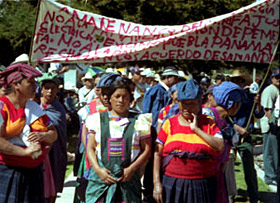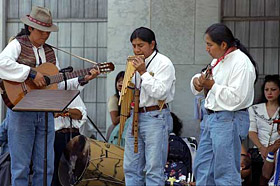 |
 |
 |
 News Around the Republic of Mexico | August 2005 News Around the Republic of Mexico | August 2005  
Indigenous Peoples Day: New Universities for a Multicultural Mexico
 Adrián Reyes - IPS Adrián Reyes - IPS


| | More than 50 peasants and civil organizations organized roadblocks on the Pan-American Highway in Chiapas, Mexico to protest the 510th anniversary of the first invasion of the Americas by Christopher Columbus on October 12, 2002. |
Mexico City - Seven intercultural universities in Mexico are going a long way towards preserving the historical and cultural roots of the country's indigenous community, which comprises more than 10 percent of the country's 106 million people.

The universities are dedicated to promoting alternatives for the development and integration of Mexico's 62 native ethnic groups.

One is the new intercultural university in the impoverished southern state of Chiapas, where the Zapatista guerrillas staged an uprising in January 1994. The university has a student body of 937, 60 percent of whom are women, and operates in the San Cristóbal de las Casas city hall.

Last year, Mexico's ministry of education began to foment ”intercultural higher education”, a concept aimed at facilitating access by indigenous people to tertiary education based on the characteristics of ethnic groups in different regions of the country.

The areas of study include language and culture, alternative tourism, sustainable development, intercultural communication, law and agroecology.

Mexico is the first Latin American country to open universities along these lines. Another intercultural university opened its doors last year in the central state of México, which is home to the Otomí, Mazahua, Tlahuica, Nahua and Matlazinca ethnic groups.

A total of 270 students - 70 percent of whom are women - registered for the first courses offered by the indigenous university.


| | Indigenous people from around the world gathered at UN Headquarters on August 5 to celebrate the International Day of the World's Indigenous Peoples. Participants marked the Day, officially observed on August 9, with a sacred pipe ceremony, music, discussions, performances, presentations and workshops. Shown are indigenous musicians performing in the Visitors Plaza. |
Sociologist Sylvia Schmelkes, general coordinator of intercultural bilingual education in the ministry of education and one of the driving forces behind the creation of the new universities, told IPS that the aim is for these educational institutions to be heavily based on the distinct cultures of the communities they serve, and to be centres for the preservation of native languages.

She announced that intercultural universities are to open next year in the states of Chihuahua, Guerrero, Puebla and Quintana Roo, in addition to the seven already operating in the states of Chiapas, México, San Luis Potosí, Tabasco, Veracruz, Sonora and Michoacán, which are economically depressed regions with high proportions of indigenous people.

One of the central aims of the new universities is to foment respect for indigenous people and their cultures and fight the discrimination and racism that they have faced for centuries, said Schmelkes.

”Indigenous people in our country need real opportunities for development, and one channel for that is through these universities,” she added. ”The authorities want indigenous people to acquire new scientific knowledge and apply it in their communities.”

”This could help lift up indigenous communities, which generally live in extreme poverty and social inequality,” said Angélica de la Peña, a lawmaker from the leftist Democratic Revolutionary Party (PRD) and the chair of the special commission on children, adolescents and families in the lower house of Congress.

On Aug. 22, the first courses begin in the intercultural university of Chiapas, which according to the local government will develop teaching and research programmes focused on integration, with the aim of producing university graduates committed to the economic, cultural and scientific development of indigenous peoples.

According to the National Institute of Statistics, Geography and Informatics (INEGI), nearly 13 million people in Mexico belong to indigenous communities, which make up the poorest sector of the population, and have the lowest level of formal education.

A large number of indigenous people from small villages or rural areas fleeing utter poverty migrate to Mexico's large cities, where they swell the ranks of slum-dwellers and urban poor. Many indigenous families survive by panhandling or selling the crafts they produce.

The states with the largest proportions of indigenous people are Yucatán (59 percent), Oaxaca (48 percent), Quintana Roo (39 percent), Chiapas (28 percent), Campeche (27 percent), Hidalgo (24 percent), Puebla (19 percent), Guerrero (17 percent) and San Luis Potosí and Veracruz (15 percent).

A study by the Autonomous Metropolitan University found that primary schools in predominantly indigenous areas present many shortcomings, because there are not enough funds to pay salaries for bilingual teachers.

In addition, textbooks often misrepresent indigenous cultures because indigenous people themselves are not consulted when they are drawn up.

The same study states that civil society organisations play an important role in bringing about changes in the educational system.

It cites the observations made by a group of bilingual teachers representing 50 communities, who are calling for efforts to teach children how to read and write in their native tongues in order to keep Spanish from continuing to obliterate indigenous languages.

According to the ministry of education, 40 native languages have disappeared from Mexico in the past few decades, and at least another 20 are at risk of vanishing.

The ministry says the creation of the intercultural universities will draw not only indigenous people but people from other sectors of the population as well into the effort to revive the 60 languages that still exist. | 
 | |
 |



